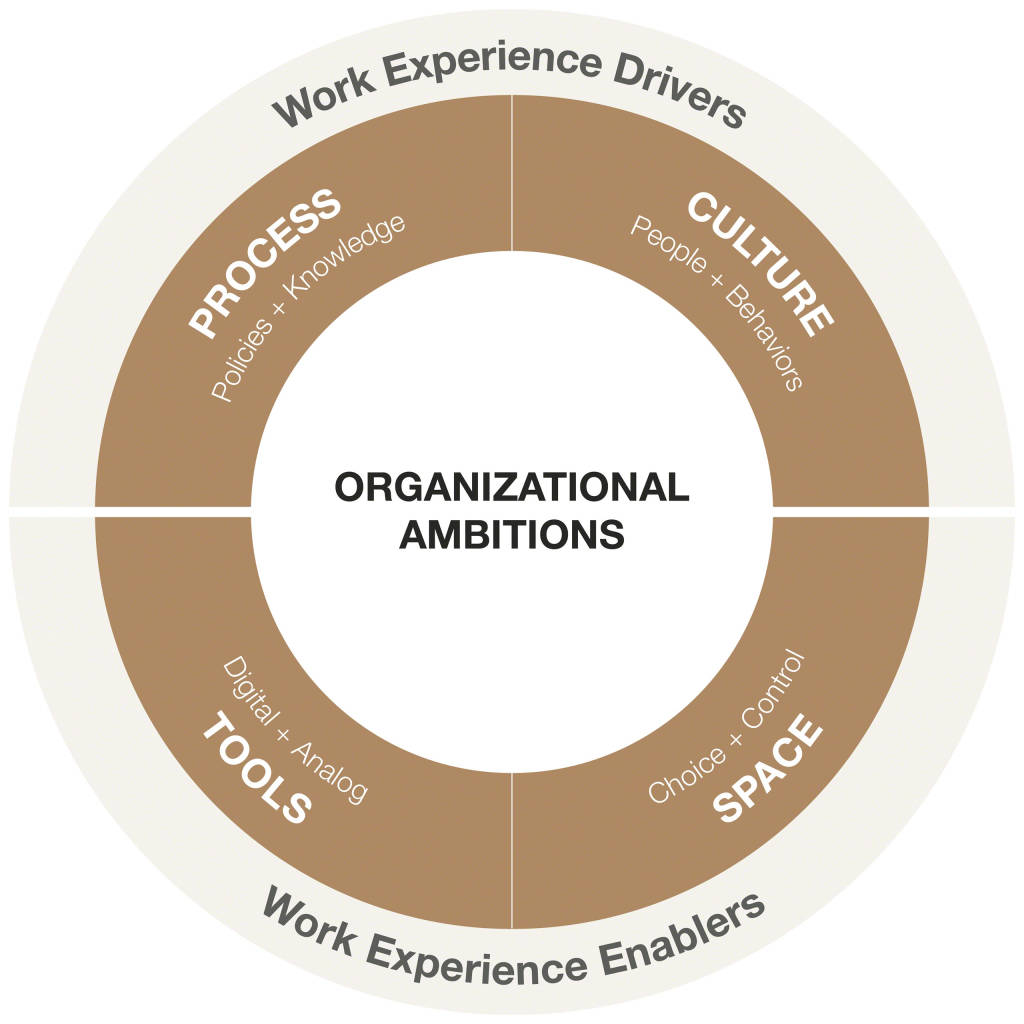Organizational Culture: Managing Your Culture by Design Rather Than Default
Seeking a healthy culture? Consider these perspectives for connecting culture and the work experience.
When cultures are strong, they are palpable. You can feel them when you travel to a different region or country or when you join a group or an organization. You can also sense culture when entering a place where the organization resides or conducts business.
Countries and regions form a context for organization’s culture (more on that in this research by Steelcase), professions have their own cultures and every organization, regardless of size, type or industry, has a culture.
We’ll focus here on organizational culture. It is a collection of behaviors and beliefs that can either inspire pride and nurture success or wear people down and sap the soul from an organization. Vibrant, flourishing cultures are marked by high engagement, open and honest communication, and prudent risk taking. Toxic cultures are awash in politics, distrust and dread.
Investing in culture might seem like investing in an intangible. Research, however, suggests a direct link between healthy culture and organizational results.
One study found that companies scoring in the highest quartile on an organizational culture survey markedly outperformed those in the lowest quartile when measuring return on assets, sales growth and market value. Managing culture is largely about focusing on behaviors, especially those that happen between people since the way we understand a culture is based on our interactions with others who are part of it. By fostering and encouraging certain behaviors while discouraging others, you can gradually shape the culture you want.
Why culture matters
Culture should be managed by design, rather than by default. In other words, be intentional. Every organization has a culture—attending to and nurturing the behaviors that make it up is important to sustaining its health—and the health of those who work within it. Crafting a vibrant culture that contributes to your business goals carries a number of benefits.
- Competitive advantage. An effective organizational culture is an important competitive advantage because it is difficult to replicate. Competitors can crib your business strategy, copy your product, or go after your customers, but they can only envy your culture. Too many variables are involved to duplicate each cultural nuance from one organization to another, and culture takes time to build and nurture.
- Organizational alignment. A well-defined culture keeps employees rowing in the same direction, focusing everyone on your organization’s mission and vision.
Motivated employees who want to join and stay. A compelling culture creates a sense of pride. Employees want to join companies with strong cultures, and they demonstrate greater enthusiasm and loyalty when they see the organization cares about culture. - Corporate camaraderie. An effective culture contributes to cohesion among departments and teams. It cultivates a we’reall- in-this-together attitude that spurs collaboration, forges community and reduces distrust.
- Better brand. Your brand is your most important differentiator. A powerful culture nurtures your brand by providing an environment in which it can thrive.
Culture and the work experience
An organization’s physical space has an enormous impact on culture. After all, just about all work experiences— and the behaviors they influence— occur in the workplace itself.
The equation looks like this: Place shapes behavior, and behavior over time leads to culture. Or, as Winston Churchill once said, “We shape our buildings, and afterwards our buildings shape us.” Place is a hosting environment for culture, the stage where culture plays out. It sends cues about what the organization values and it is never neutral—always sending messages about the culture.
For example, an open environment with unobstructed sightlines and a generous choice of informal meeting areas may suggest a company values collaboration. Or private offices along the windows with a warren of cubicles throughout the interior demonstrate that hierarchy matters. In another example, a work café and prominent open staircases could indicate an organization prizes interaction and wants to encourage unplanned encounters.
The workplace can support a sense of community, flexible working arrangements, tech-centric values, a collegial climate, experimentation and innovation—whatever the culture requires. As a contributor to culture—and in fact, the most visible manifestation of culture—your physical space deserves priority attention.

+ Consulting (ARC) group helps
organizations around the world
define, realize and sustain their
desired culture. The group’s
approach recognizes culture
is part of a bigger picture that
includes process, tools and
space. All four attributes must
work together to create a work
experience that contributes to an
organization’s chief ambitions—
greater collaboration, faster
innovation, more effective
recruitment—whatever they
might be.
Focus on creating holistic experiences
The role of behavior in influencing culture can’t be overstated. Put simply, managing culture means managing behavior. Transforming culture is largely a matter of determining the desired behaviors that will lead to preferred results.
Organizations often make the mistake of ignoring the development of a strategy focused on behavioral change and focus solely on results. The theory is that if you simply do a better job of clarifying and reinforcing desired results, people will do what it takes to produce them.
This rarely works. A better strategy is to view results as the pinnacle of a four-stage pyramid. First described in “Change the Culture, Change the Game” by Roger Connors and Tom Smith, the results pyramid begins with 1) experiences, which drive 2) beliefs that encourage 3) behavior which leads to 4) results.
From a leadership standpoint, it might work like this:
- Experience My boss gives me minimal direction, providing positive guidance when necessary.
- Belief My boss trusts me.
- Behavior I take action and make decisions.
- Result My project gets completed on time and pleases the customer. From a workplace standpoint, it might look like this:
- Experience My boss often uses the work café for meetings or solo tasks.
- Belief It’s acceptable to work away from my desk.
- Behavior I find myself connecting informally with people I would rarely see otherwise.
- Result Our organization is less siloed, more efficient and more innovative.
Building on a foundation of positive work experiences will ultimately encourage the kind of behavior that can shape your desired culture.
Nothing changes until leader behavior changes.
Rensis LikertOrganizational Psychology Thought Leader
Taking the lead
If the key to shaping culture lies in behavioral change, some of the most important behaviors to leverage are those demonstrated by leadership. As Rensis Likert, a thought leader in organizational psychology describes it, “Nothing changes until leader behavior changes.” The reason for this is an organization’s culture typically mirrors the style of its leaders. Through their actions, leaders have an opportunity to model the behaviors and values required to support the desired culture.
Employees tend to focus on leaders as a source of cultural cues because their behaviors are typically more visible and prominent. Leaders’ scale of responsibility tends to be larger, so more people typically see their style and approach. In addition, because they are in positions of leadership, people assume the company values what they do. Consequently, leaders hold a key role in reflecting culture and sending messages—intentionally or unintentionally—about culture’s core characteristics.
For example, if your company insists you value transparency, but leaders jealously guard information, you will never eliminate silos. Or if you want fast decision making ingrained in your cultural profile, proposals can’t languish on a leader’s desk. Moreover, the leader with a perpetual scowl sends a very different signal than the one who consistently demonstrates positivity.
People watch promotions especially closely. If organizations regularly promote people adept at playing politics—but not so good at playing well with others—your cultural values will come through loud and clear regardless of what you purportedly advocate. That’s not to say new leadership provides a quick fix for a struggling culture. Culture tends to change slowly, and there is always a lag between the arrival of new leadership and the successful infusion of a new leadership style.
Bear in mind, that organizations can have multiple subcultures— departments, business units and teams that don’t necessarily mimic the company. Any variances are largely due to different leadership styles. The most empowering corporate culture means little if your immediate boss controls every decision. Conversely, a toxic organizational culture might be more bearable if your group or team thrives under exemplary leadership.
Ideally, organizations select and promote leaders who demonstrate behaviors consistent with their desired culture, and they cultivate stories about leadership behaviors which contribute to an understanding of the preferred values. Organizations are also made stronger when they manage leaders appropriately in cases where their behaviors are inconsistent with desired cultural patterns.
Culture and Engagement
Sometimes people mix the concepts of culture and engagement, and while they are certainly related, they are not synonymous. Culture is a collective experience and it is how the work gets done. Engagement, on the other hand, is a more individual experience and points to how people feel about their work.
Culture is the accumulation of behavior over time and related to values, norms and assumptions. Engagement is defined as energy, passion, and pride in addition to vigor, dedication and absorption. This matters for business because when people feel energized and vigorous they tend to contribute discretionary effort—going that extra mile for their work and their colleagues.
Another difference between culture and engagement is related to time horizons. Culture tends to be more stable and long term, while engagement is more flexible and shifts over time. Engagement metrics are more of a snapshot—potentially shifting from week-to-week or monthto- month. Finally, engagement is an outcome of culture. When cultures are positive, constructive and productive, engagement is one outgrowth.
Like culture, engagement also has a relationship to place. In fact, Steelcase research proved correlations between the two. When people had a greater sense of satisfaction with the workplace, they reported greater engagement and when they had more choice over their work experience, they were also more likely to be engaged.

Culture lessons learned
Part of the challenge with managing culture lies with the many variables at play and the various levers to pull. Here are 10 tips to consider as you travel the path toward a productive culture.
- Be intentional. Culture is always evolving, never stagnant. Left alone, it will take on a life of its own, gradually morphing into something you may not want. Culture—and the behaviors that make it up—should be managed intentionally, never left to chance.
- Be explicit. Make sure the behaviors, values and norms that drive your culture are explicit. Reinforce them frequently in communications, conversation and by example. Every business unit, department, team and individual should know exactly what is expected.
- Compare expectations to experience. Your work experience must reflect your desired culture. Any mismatch between expectations and the workplace experience will have a negative effect on morale. If an organization has a reputation as a cool place to work with plenty of openness and innovation, but new hires find it to be dark, drab, stodgy and stifling, they will be disappointed. Conversely, if the work experience equals or surpasses their expectation, they will be delighted.
- Leverage leadership. Dynamic, engaged and transparent leaders are essential to a constructive culture. In addition, when leaders are present and accessible in the space, they can communicate and model desired behaviors, values and norms. Leaders are integral to creating an environment for culture to thrive and this often means they are visible and accessible to the organization.
- Speak the same language. Most organizations lack literacy in the language of culture. This creates a problem because it is impossible to manage something if you can’t discuss it. Encourage explicit language about culture. “I love that we always start on time.” “We value speed, so I’ll get this back to you by Wednesday.” “If we’re supposed to be innovative, why are we so reluctant to give feedback to leaders?” By inserting culture into the daily conversation, you will keep it top of mind.
- Hire the right people. If you want a culture driven by certain values, hire people who possess those values. This is known as “culture fit” versus “culture add.” It can be more comfortable to hire for those who fit the current culture because they are similar to people who already work for the company, but it is more powerful to hire for those who will add to the culture and help stretch the culture and desired behaviors. Ultimately, it is far easier to use desired cultural criteria as a hiring filter than to instill the right values after people are already on board.
- Meet individual and organizational needs. An effective culture must satisfy both individual and organizational needs. Satisfactory financial results will be unsustainable if achieved while micro-managing employees. Conversely, a laissezfaire approach to management might seem appealing to employees, but if there is no accountability in the organization, it will flounder.
- Be mindful of brand. Your culture must align with your brand. For example: If your brand stipulates the customer always comes first no matter what, your culture will need the flexibility to deliver. If your people don’t feel empowered to stray outside of traditional policy, delivering on your brand promise will be challenging.
- Healthy beats strong. Be careful about wishing for a strong culture. A strong culture can just as easily be negative as positive. It may be better to seek a healthy culture. Healthy cultures empower people, recognize talents, clearly define roles, trust people with responsibility and hold them accountable.
- Expect a lot from teams. Teams are where people experience culture most directly. Team members should understand they subtly reflect culture with every interaction. How they reinforce or discourage certain behaviors matters.
These tips can take some of the mystery out of crafting a culture that helps realize your organizational ambitions. Although, the biggest mystery may be why more organizations don’t make culture a higher priority.


